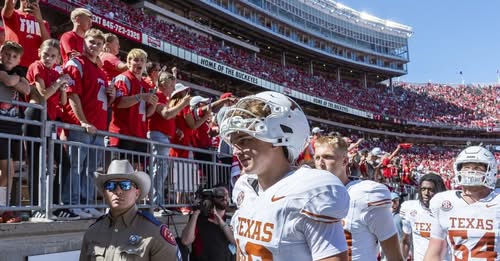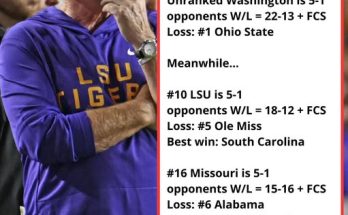Arch Manning entered the 2025 season with a level of attention and scrutiny few college quarterbacks have ever experienced. Carrying one of the most storied surnames in football, the Texas Longhorns sophomore was tasked with leading his program into a highly anticipated Week 1 clash against the Ohio State Buckeyes, a team ranked third nationally and widely regarded as one of the deepest rosters in the country. The game, played under the bright lights of prime time, was billed as Manning’s defining moment, the stage on which he could announce his arrival as not just a promising talent but a legitimate college football star. Instead, what unfolded was a night of growing pains, frustration, and, ultimately, the reality of how difficult it is for even the most heralded quarterbacks to rise instantly to meet sky-high expectations. Texas fell short, 14-7, as Ohio State’s defense suffocated Manning and the Longhorns offense for much of the contest. Though Manning showed flashes of poise and resilience late in the game, the weight of three uneven quarters proved too much to overcome.
From the opening possession, it was clear that Ohio State’s defense intended to test Manning’s composure. Defensive coordinator Jim Knowles dialed up pressure from multiple fronts, sending linebackers through gaps and disguising coverages to force Manning into hurried decisions. For much of the first half, the young quarterback looked unsettled. His timing with receivers was inconsistent, and Ohio State’s secondary pounced on mistakes. Passes sailed high, others skipped short, and several potential big plays were erased either by overthrows or Buckeye defenders closing gaps before Texas wideouts could gain separation. Manning’s stat line at halftime reflected the struggles, with fewer than 100 passing yards, a completion percentage under 50, and no points on the board.
The frustration mounted for Texas fans, who had hoped their prized quarterback would live up to his lineage under the biggest of spotlights. After all, Manning had been recruited with the expectation of delivering the Longhorns back to national prominence. When Texas joined the SEC, his commitment was viewed as a symbolic turning point, a message that the program was back among the sport’s elite. But against a veteran Ohio State defense stacked with NFL-caliber talent, the learning curve was steep, and the game offered a sobering reminder that pedigree alone doesn’t guarantee instant dominance.
Despite the struggles, Texas remained within striking distance. The Longhorns’ defense did its part, keeping Ohio State’s high-powered offense largely in check. Quarterback Julian Sayin, making his first career start for the Buckeyes, had his own difficulties against a relentless Texas pass rush. The Buckeyes managed two touchdowns, one in each half, but neither came easily. Linebackers flew to the ball, the secondary made key pass breakups, and Texas’s defensive front stuffed several key third-down runs. By the time the fourth quarter arrived, the Longhorns trailed 14-0, but the game still felt winnable if Manning could find rhythm.
It was in that fourth quarter that glimpses of the quarterback Texas fans had been promised began to emerge. Manning settled into the pocket with more confidence, anticipating throws earlier and reading Ohio State’s coverages more cleanly. His footwork improved, and he began connecting with receivers on intermediate routes that had been shut down all night. A 22-yard completion to tight end Gunnar Helm sparked the Longhorns’ best drive of the game. Manning then found Xavier Worthy’s replacement, Johntay Cook II, on a crucial third-down slant to move Texas inside the red zone. Moments later, he capped the drive with a strike to Cook in the back of the end zone, cutting the deficit to 14-7 with under six minutes remaining.
The touchdown ignited the Texas sideline and reawakened the stadium, as it seemed Manning might yet engineer a signature comeback against one of the nation’s premier defenses. On the next possession, the Longhorns’ defense forced a quick three-and-out, handing the ball back to Manning with just over four minutes to play. The narrative was practically writing itself: a young quarterback, long burdened by the weight of his last name, about to silence doubters by leading his team to a dramatic win.
For a few plays, that story felt possible. Manning connected with Isaiah Neyor on a 15-yard out route, then scrambled for a first down after evading pressure from two Buckeye defenders. But the drive eventually stalled near midfield. On third-and-7, Manning looked deep for Cook again, only to have his pass broken up by Ohio State cornerback Denzel Burke. Facing fourth down, Texas kept the offense on the field, but Manning’s attempt to fit a ball into tight coverage fell incomplete, ending the Longhorns’ hopes.
The final whistle cemented a 14-7 loss, and though Texas had fought valiantly, it was impossible to ignore the offensive inconsistency that plagued them for three quarters. Manning finished with a modest stat line: 18 completions on 36 attempts for 204 yards, one touchdown, and one interception. The numbers told the story of a quarterback still adjusting to the speed and complexity of elite college defenses.
In the aftermath, the conversation surrounding Manning was as intense as expected. Critics pointed to his surname and recruiting hype, arguing that the pressure of being a Manning weighed too heavily on his shoulders. Supporters countered that few quarterbacks in the country would have thrived against Ohio State’s defense in that environment, and that Manning’s resilience in the fourth quarter was evidence of his potential to grow into the role Texas envisioned for him. Both perspectives carry weight.
The reality is that football history is filled with quarterbacks who struggled early before developing into stars. Peyton Manning threw more interceptions than touchdowns as a college freshman at Tennessee. Eli Manning, too, had growing pains before finding his stride at Ole Miss. Even the most talented prospects must endure tough nights where defenses outmatch them. What separates good quarterbacks from great ones is how they respond to those moments. Arch’s fourth-quarter rally, though incomplete, hinted at a mental toughness and competitive spirit that can’t be measured by statistics alone.
For Texas, the challenge moving forward will be balancing patience with urgency. The Longhorns are no longer content to simply compete; they aspire to win championships. With SEC play looming, Manning will need to elevate his game quickly, learning from the mistakes against Ohio State while building on the confidence gained in that late rally. His chemistry with receivers will be critical, as will his ability to handle pressure from defensive lines that will only get stronger in the weeks ahead. Offensive coordinator Kyle Flood will also face scrutiny, as Texas’s game plan for much of the night seemed conservative, leaving Manning with few easy completions to build rhythm. Adjustments in play-calling may be necessary to help their young quarterback succeed.
Ohio State, meanwhile, walked away with validation of its defensive dominance and the promise of Julian Sayin under center. Though Sayin wasn’t spectacular, he did enough to secure the win, and his composure in his first start against a tough Texas defense was encouraging. The Buckeyes’ ability to win without lighting up the scoreboard reflects the kind of balance championship teams need. Their secondary looked elite, their pass rush was relentless, and their linebackers flew to the ball, leaving Manning with almost no margin for error.



